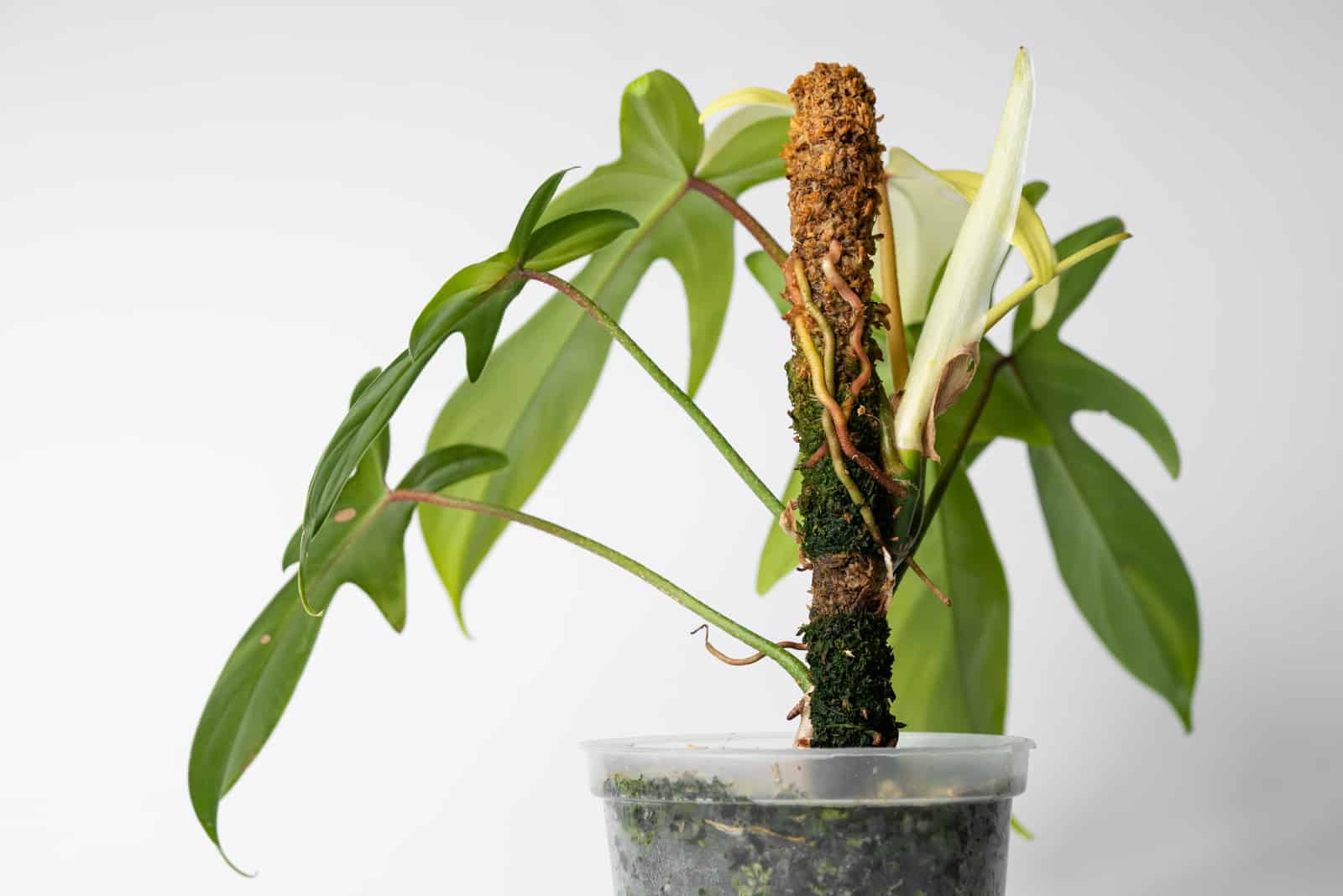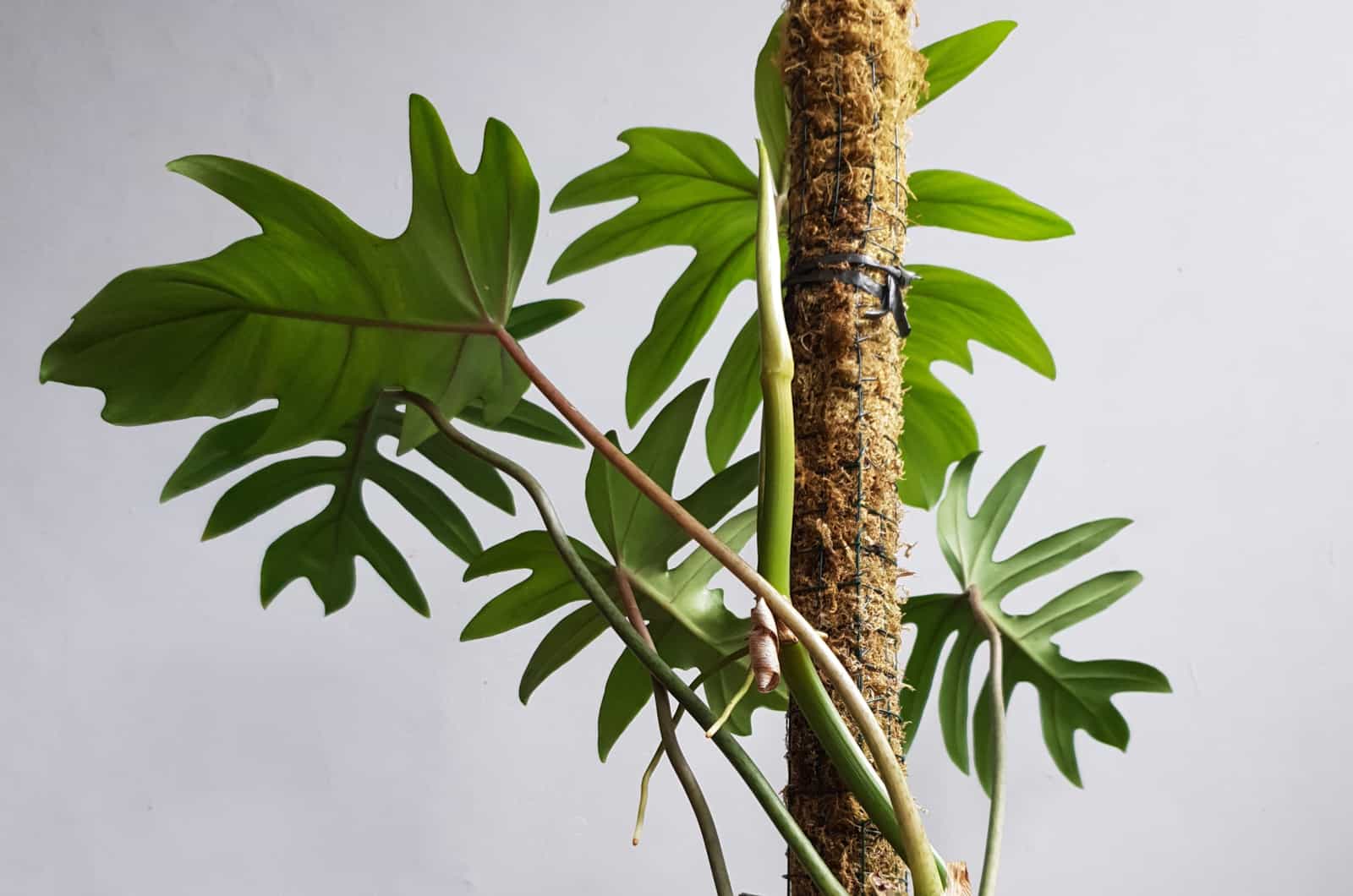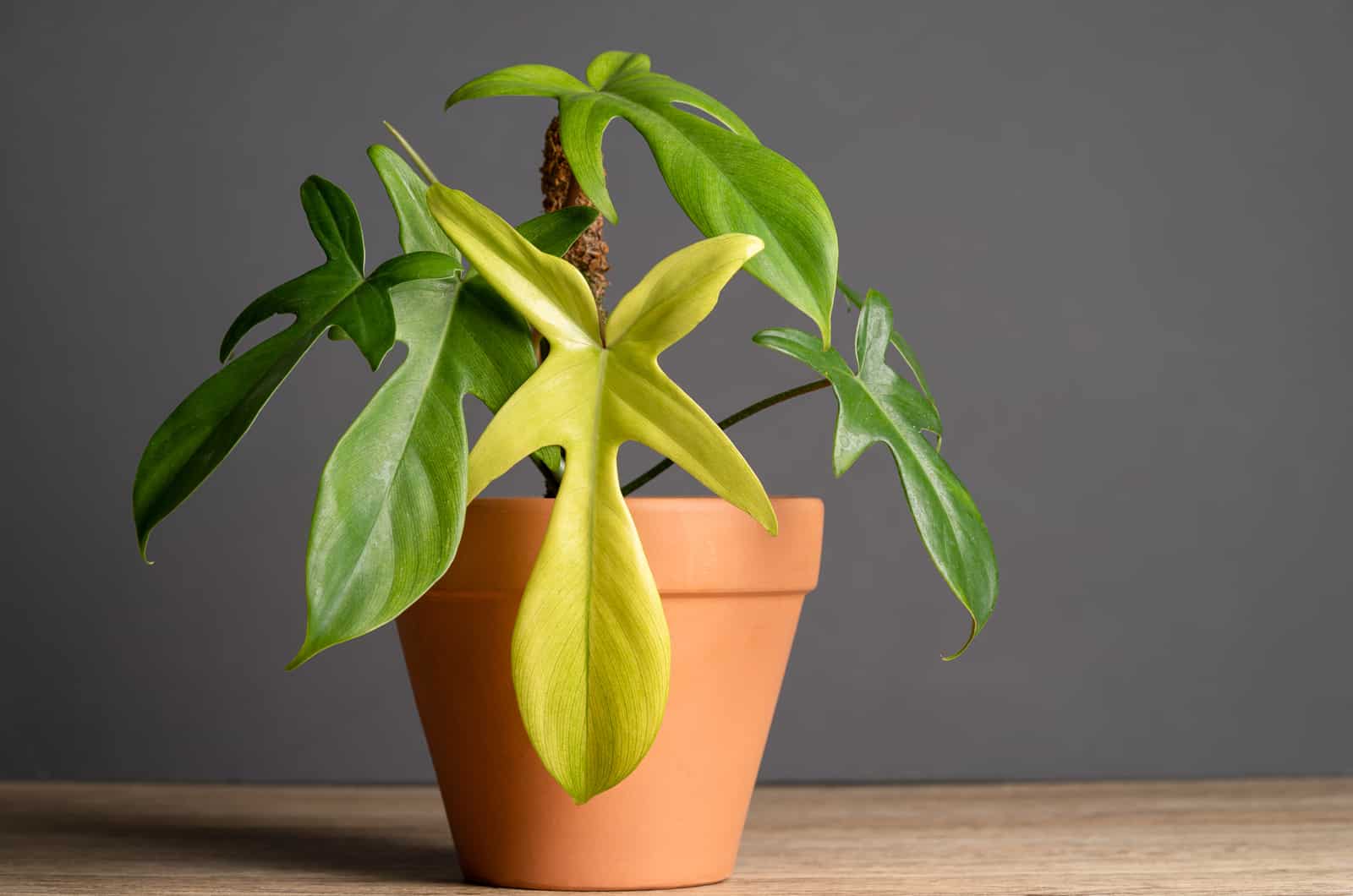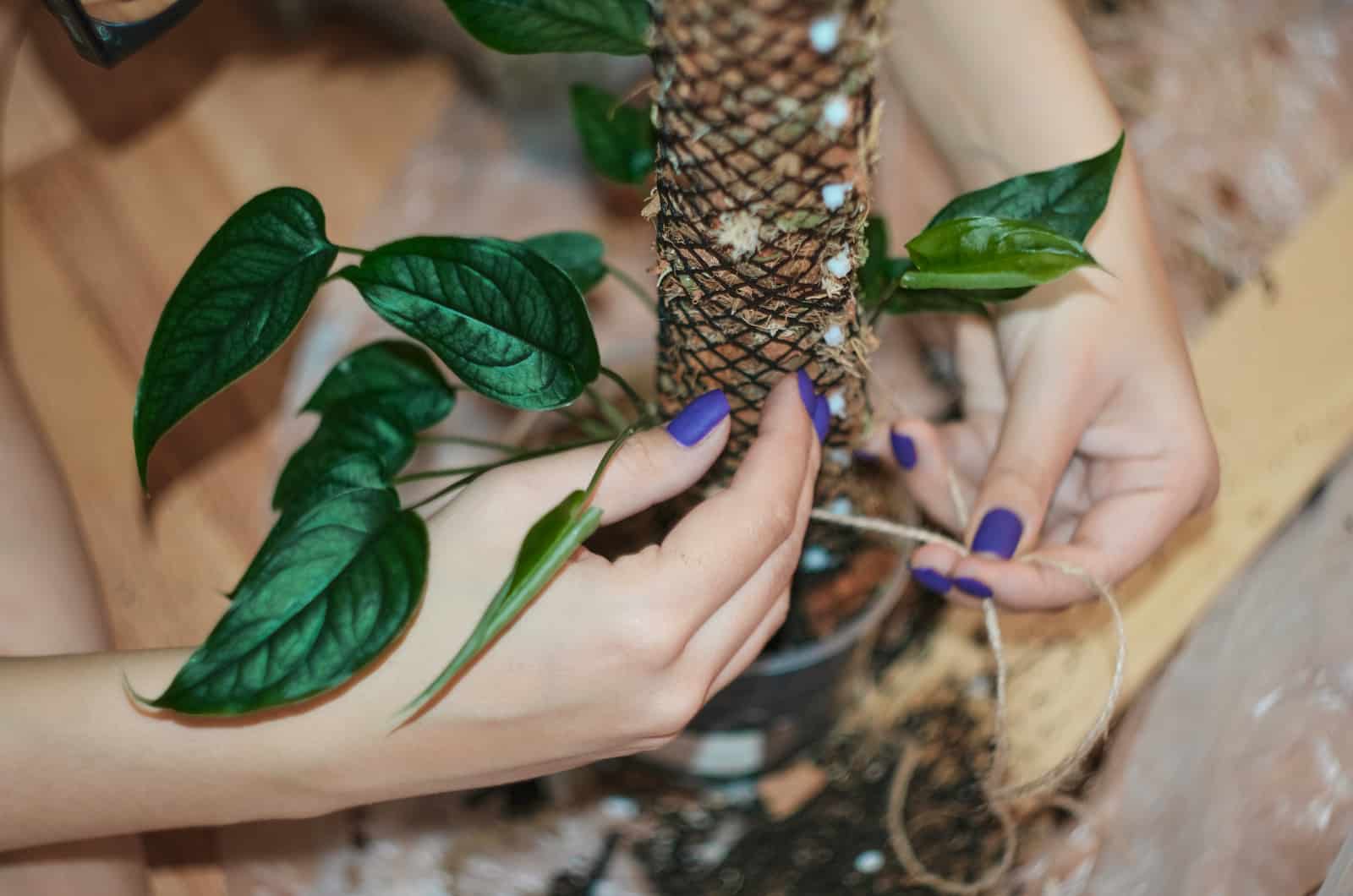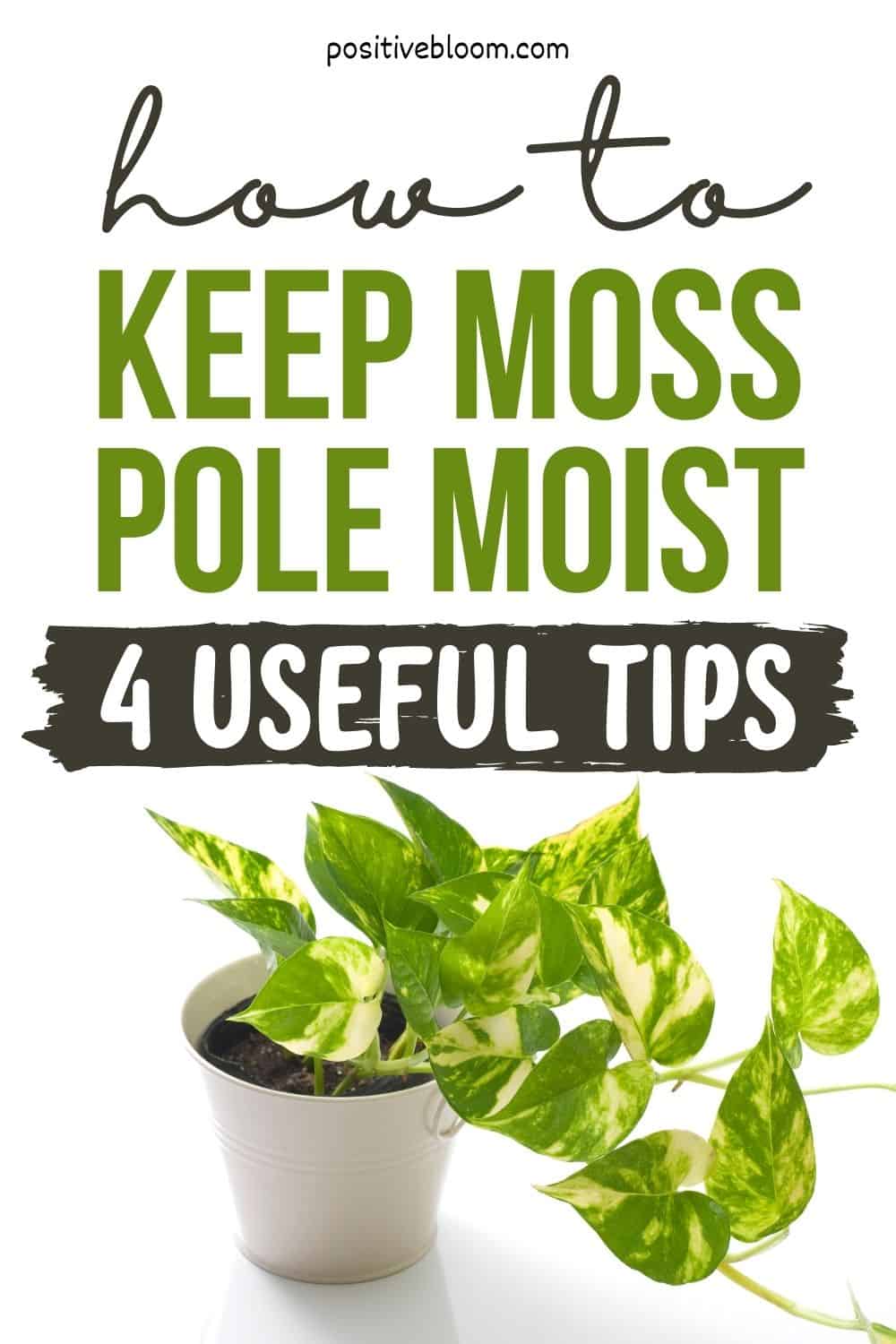There are many climbing plants that look simply stunning when grown on trellises or moss poles, but we feel as if we hit a brick wall once they start to dry.
Therefore, we decided to look into the matter in more detail and bring you our four best tips to resolve all your dilemmas. Never again will you wonder, “How to keep moss pole moist?”.
We’ll also answer some crucial questions about moss poles, such as why some plants need them and how to train your plants to grow on them.
There is so much to learn, so let’s get started!
How To Keep Moss Pole Moist: 4 Helpful Methods
We have some amazing tips and tricks for keeping your moss pole moist and your monstera plants happy. We also have a handy step-by-step guide for making self-watering poles, so you can be sure your Swiss cheese plant is satisfied with its support.
The best way you can help your epiphytes is by making them a self-watering moss pole. If you haven’t had the time or the means to do so, you can always mist the moss and control the environmental conditions to provide a perfect care guide for your hoya fungii or some other vining plant.
1. Misting
The easiest way to keep your moss pole moist and ensure proper plant growth is by misting it from time to time.
Sphagnum moss acts like a sponge: it traps water and releases it whenever your Monstera deliciosa gets thirsty. You should mist your pole a couple of times a week, or more if you live in arid climates, and get a good hygrometer.
2. Water Bottle Method
The water bottle method is another way of keeping your philodendrons and pothos moist and encouraging them to grow larger leaves.
The good news is that you don’t need any special materials for the dripping water bottle method to work; just a plastic bottle, needle, and some wire or tape will suffice.
However, you need to prepare your moss pole beforehand. I love using PVC pipes for this method as it’s easy to make a few holes in them that will allow the water to get to the moss. Wrap the pipe with moss and fasten it with a twist tie or some jute twine.
After your self-watering pole is done, use a needle to puncture 3-4 holes in the plastic bottle and tie the bottle to the stake. You can fill the bottle before or after securing it, but I find it easier to tie an empty bottle than a full one.
Now all that’s left is to fill the bottle with water.
Don’t forget to add more water every once in a while to help your plants thrive.
3. Wicking System Method
Another way to create a self-watering moss pole is with a PVC pipe end piece secured with silicone. This will stop the water from leaving the pipe and overwatering the soil.
Tie a knot in the wicking cord and place it in the pole (you want it to touch the bottom). Leave the rope in the pipe, securing it with your finger while sliding it down one side of the tube. Cut it approximately 10 inches (25 cm) longer than the pipe, and tie it to the pole with some zip ties.
Wrap the wicking cord around the pole before also tying the bottom part. The cord will transfer the moisture onto the moss when watered and keep it from drying out.
After you’re done with assembling the wicking system, simply wrap the moss around the pipe and secure it with either mesh, some twist ties, jute cord, or something else.
Now that you’re all done, simply pour water into the pipe until it’s full, and enjoy your healthy houseplant! Water the moss pole frequently to keep it and your plant healthy.
Check out this great tutorial for making the wicking system and a self-watering pole that will ensure the best plant care for your Monstera adansonii or any other aroid:
4. Controlling Weather Conditions
You must also ensure that your moss pole doesn’t dry out too quickly due to climate and weather conditions. You can do this by moving it away from direct light, ensuring the proper humidity levels, and protecting it from the wind and windy areas.
The following sections will examine all these techniques in more detail and show you how best to care for your moss pole and the tropical plants growing on it.
Keeping The Pole Away From Direct Sunlight
We all know that heat and too much sunlight contribute to faster water evaporation, so it’s not surprising that moss poles kept in direct sunlight tend to dry out quickly.
However, you shouldn’t keep them in the complete dark either because that would only harm your beautiful Hawaiian pothos. Place the plant in indirect light where it’ll still have suitable conditions to photosynthesize, but where direct sunlight won’t hurt its foliage or dry out the moss.
If you have a self-watering pole, you don’t have to worry about the moss drying out.
Maintaining Proper Humidity
Low humidity also leads to moss poles drying faster, however, this problem is easily fixed.You just need to purchase a powerful humidifier to slow down the evaporation of water and increase the level of air moisture around your plant and pole.
Even though a humidifier is the best option, it’s not the only one. You can move your plants to more humid rooms like bathrooms and kitchens to prevent the moss from drying out completely (you’ll also have good company while cooking, and who doesn’t enjoy that?).
Unfortunately, pebble trays aren’t particularly beneficial for larger plants as the water vapor would just disperse around the room. However, you can place some pebbles and water in a large (and I mean aquarium-large) container. The glass walls will keep the moisture in long enough for your moss to soak it in.
Keeping The Moss Pole Away From Windy Places
Finally, you should keep your sphagnum moss pole (and your plants) away from windy and drafty places at all times. Wind dries out the air and speeds up the drying of the moss, so keeping your plant and moss pole away from these places can keep them hydrated for longer periods.
Therefore, never place your staked plant near drafty windows, below the air conditioning, or near heaters and radiators, as you’ll only invite more problems than you’d solve.
Why Do Plants Need A Moss Pole?
There are many benefits to moss poles: they help your plants grow bigger leaves, provide them with extra support, moisture, and conditions found in their natural habitat, and can even offer your indoor plants the micronutrients they need for healthy growth.
Moist moss acts as another source of water, so you can forget about underwatered syngoniums and philodendrons.
Most tropical plants are native to rainforests and grow on other plants (usually trees), from which they take the water and nutrients they need. In order to mimic these conditions, we often turn to moss poles because we all appreciate healthy plants with large leaves.
However, you don’t specifically need a moss pole to achieve this. There are many moss pole alternatives you can order on Amazon or make yourself, such as bamboo stakes, tree slabs, dowels, or planks that mimic the tree trunks vining plants grow on in their native habitats.
Even metal or plastic meshes and trellises are suitable substitutes for moss poles if you don’t have anything else at hand.
If you don’t like the mess that comes with moss poles, you can use coco coir to make coir poles and use it as a totem for excellent DIY plant support.
Which Plants Need Moss Poles?
All vining houseplants should be grown on moss poles, but it can be difficult to tell if the plant is a vine.
Some aroids and tropical plants are epiphytes, which means they have long stems and aerial roots they use to attach to trees. These plants thrive in those conditions, which is why you should try and mirror them.
Pothos, monsteras, and philodendrons are primary examples, but syngoniums and hoyas aren’t far behind on the list. There are also trailing begonias and money plants, which will do wonders for your home decor.
If you want your home to give off that Santorini vibe, there is a climbing bougainvillea that can grow over an entire wall, and perhaps even a house if you let it! Jasmine is another prime example of vining plants that can even be used as ground cover.
Growing these varieties inside your home requires some boundaries, and that’s why you can always turn to moss poles. They’ll give your plants structure and make them a true sight to see.
How To Recognize Vining Plants
If you don’t know whether or not your plant is a climber, there are a few things you can look out for.
The main tell is their stems. Climbers have elongated stems – younger plants have thinner, leathery stems that may even look like shoelaces, whereas older plants appear woody.
All vines have aerial roots, so if you notice tiny tendrils around leaf nodes (the places from which leaves grow), you can be certain you have a climber on your hands.
Another thing that can help you identify whether your plant is a vine is the way in which it grows. If it curls and wraps around objects or starts crawling down the pot, you’ve got yourself a climber.
Why Should You Keep The Moss Pole Moist?
Now that you know why some plants need moss poles, you may be wondering why you need to water them in the first place. What if you don’t want additional moisture for your plant? Can’t you simply water it, and that’s it?
Well, moss is also a plant, and it needs water to stay alive. Dead moss doesn’t look particularly attractive, and it will die without water.
Also, moss holds in nutrients as well as water, and your plants can draw from this additional food source if their soil is poor. However, dead moss cannot retain anything, so you should water it to keep it alive.
You can revive your moss in some cases, but it takes plenty of water-soaking; it’s easier to just water it from time to time than bring it back to life.
Finally, aerial roots seek nutrients and moisture, and without them they won’t attach to the stake. So, don’t forget to water or mist your pole from time to time.
How To Attach Plants To Moss Poles
Climbing plants need the same things as all other plants, sufficient water, light, and nutrients. However, the care guide for trailing pothos and all other vining plants includes something else: poles, stakes, or trellises.
Therefore, to help your epiphytes thrive you need to grow them on a moss pole or some other support. You’ll notice bushier growth with large leaves in no time.
Climbing plants grow aerial roots to attach to trees or, in our cases, moss poles. They need a little help in their early stages of life, so you should attach them to the stakes and trellises yourself.
You can secure your plants in a variety of ways, but here’s how we do it:
Step 1. First, pin the large stem to the pole with U-shaped metal staples, which will keep them in place until you can get the cord to tie the plant.
Step 2. Then, fasten the plants with a piece of wire or twine. Bind the plant to the pole so that it doesn’t fall down, but don’t tighten the cord too much; you want to secure the plant, not suffocate it.
Plant velcro straps are a good option as they don’t slice into the plant, but they can be unsightly, especially if you tie a plant with them. However, zip ties offer the same attachment as velcro straps and twine, so you can use them for safer and more secure attachment.
Step 3. Finally, keep in mind that some plants need just a slight push and not too much help with attaching to the pole. Therefore, gently wrap them around the pole and make sure that the aerial roots have something to hold on to.
Here are some great tips for adding your plant to a moss pole if you still have some doubts:
Frequently Asked Questions
We answered some critical questions about moss poles: how to keep them moist, why we need them in the first place, and how to attach plants to them.
But there are still some other questions that need to be addressed. We will answer some of the most frequently asked questions about moss poles to help your (and our) plants thrive.
Let’s see what you asked us!
How often do you water a moss pole?
It really depends on the climate and weather conditions, but in general you should water your moss pole twice a week. You can also spray it with water throughout the week because it cannot be overwatered – it just holds moisture in and releases it when your plants need it.
However, if you live in a drier region, you should water your moss pole more frequently to prevent moisture loss.
Finally, use filtered water if possible because tap water is usually full of chlorine, which can cause your moss to turn brown and may even be harmful to your plants.
How to make a DIY moss pole?
To make a moss pole, you need sphagnum moss, metal mesh, wire cutters, and zip ties.
Soak the sphagnum moss in water for a minute or two (although soaking it for longer won’t do any harm). Don’t use too much, though, because you’ll have to discard it.
Cut the metal mesh to the desired size, fill it with moss, and tie the metal mesh with zip ties one at a time.
Trim the ends of zip ties and then fill them in if necessary. You can also cram any moss that’s protruding through the mesh with any blunt object thin enough to pass through the mesh.
The video below will help you make your first moss pole without pipes and wooden stakes, that still provide the same benefits to your plants:
Do you soak a moss pole?
Yes, you should soak a moss pole before placing it in a pot because plants need moist moss in order to attach.
However, you can simply soak the moss before making a moss pole as this will make this job (and your life) easier. You can always find a bowl or a bucket to fit your moss in, but moss poles are a bit trickier, especially if you want to make a larger one.
Do you wet a coir pole?
Thankfully, there’s no need to wet a coir pole before or after planting. However, if you’re making your own coir pole, you can mist it a bit and tie it with some twine.
This type of stake is perfect for you and your home because it doesn‘t need watering and you don’t need to change the dead moss. It doesn’t leave a mess like moss does either.
Your plants will also adore this pole as they can easily penetrate and attach to it because coir is quite porous.
Summing Up
You can sleep soundly now that you know the answer to the question, “How to keep moss pole moist?” There are many interesting ways to do so; you can either make a self-watering moss pole that you fill with water from time to time, or mist your regular moss pole every now and then.
However, you should also pay attention to the weather conditions, as too much sun, heat, and drafts can dry out the moss. You can move your plants to a more humid room or get a humidifier to maintain the desired humidity levels.
We also answered your many questions about moss poles and climbing plants, such as why plants need them, which plants are climbers and how to recognize them, how to teach plants to grow on them, and more.
We wish you good luck with your vining plants!
Until next time!
Like this post? Share or pin it for later!

